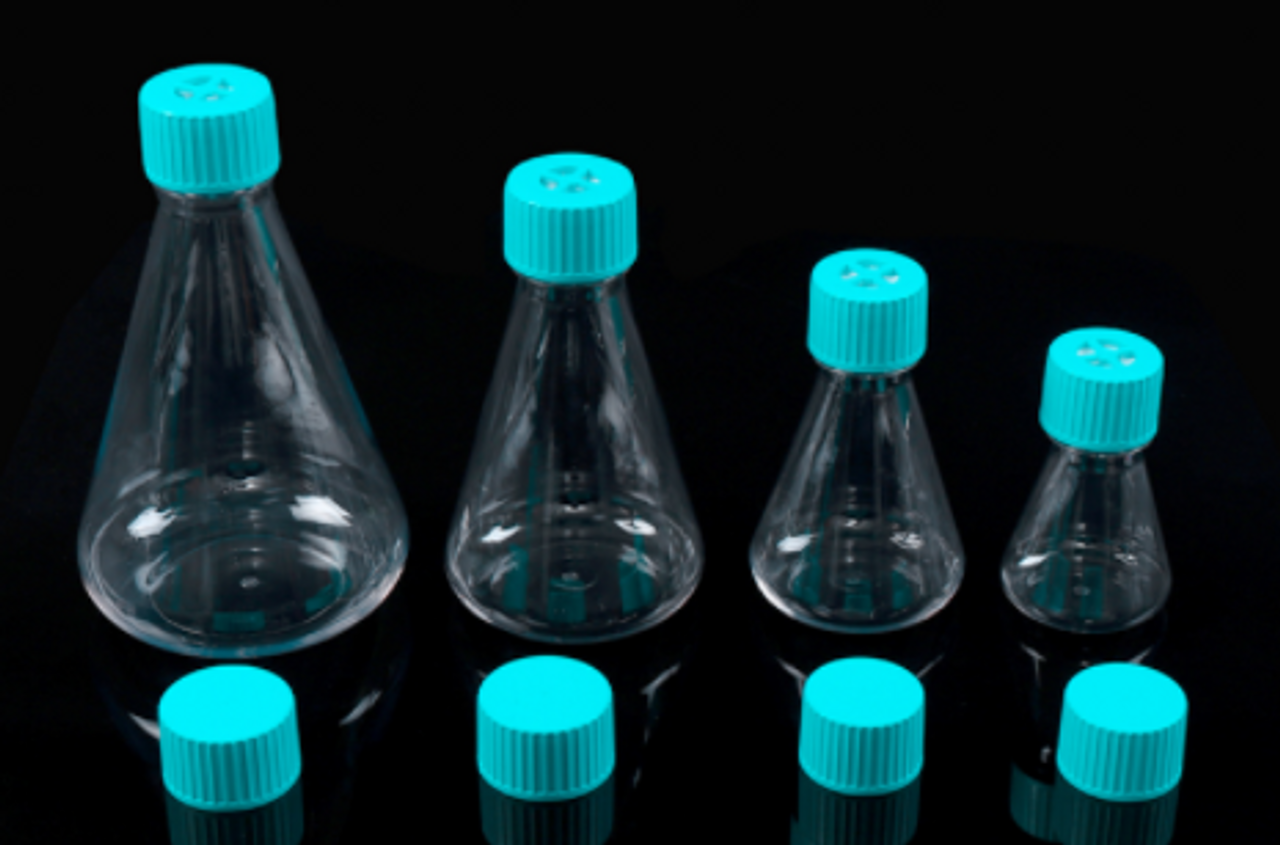Some cells grow best when left untouched while
others, like suspension cells, bacterial and yeast cells, require vigorous
mixing to create the right environment for cell reproduction.
One of the most commonly used vessels for shaking and aerating growing cells are Erlenmeyer flasks.
An Erlenmeyer flask looks like a triangle with a wide base that slopes as it climbs upwards and finishes with a narrow neck.

The lower half of an Erlenmeyer flask provides sharp angles for thorough mixing, while the high neck prevents liquids and solutions from spilling.
Plastic Erlenmeyer flasks are safer and more convenient to use.
Plastic Erlenmeyer flasks are made from either PET or polycarbonate and are sold pre-sterilized in individually wrapped packaging. Both materials offer glass-like clarity and are available in volumes ranging from 50mL up to 5L.
If the lab requires greater capacity than five liters, they will need a glass Erlenmeyer flask or to purchase a fermenter or bioreactor.
Using anything made from glass always presents a safety concern for the lab, so plastic Erlenmeyer flasks are frequently chosen as a shatter-free alternative.
Plastic Erlenmeyer flasks are meant to be used once and discarded. This eliminates the timely and unpleasant job of scrubbing clean previously used glass flasks.
Budget conscious labs can autoclave their polycarbonate Erlenmeyer flasks, extending their usefulness.
When to choose a vented or plug-sealed Erlenmeyer flask cap?
Anaerobic cell cultures require caps that can be completely sealed.
Where gas exchange is needed, a vented cap with a .22-micron membrane allows for free flow of oxygen and other nutrients while blocking viruses and other contaminants from entering the Erlenmeyer flask.

Vented Erlenmeyer flasks should be secured upright to prevent liquids from contacting the porous cap and leaking.
Some lab glassware brands offer glass Erlenmeyer flasks with GL45 screw caps for additional peace of mind when storing, shaking or transporting.

Which is better? Flat bottomed or baffled bottom Erlenmeyer flasks?
There are benefits and potential pitfalls with either flask type.
Standard flat bottom flasks gently swirl liquids around in a very predictable fashion consistent with their geometry. There is less risk for cell-shearing and lower incidence of foaming.
However, flat bottomed flasks are not as efficient at oxygen transfer, and this can impact successful growth of the microbial material.
Flasks with baffles embedded in their base introduce turbulence into the flask which enhances vertical and circular motion and increases aeration.

Baffle bottom flasks introduce the risk of foaming which can impede oxygen transfer and negate the benefit of the baffles.
Reproducibility can also be an issue with baffle bottomed flasks if there are inconsistencies in the precise placement of the baffles from lot to lot.
When does it make more sense to use a glass Erlenmeyer flask?
Glass Erlenmeyer flasks are pricey upfront but offer a long life of service that pays for themselves many times over.
Disposables are convenient but might not be the right choice when funds are tight.
Glass can be cleaned and autoclaved indefinitely.
Media can be sterilized inside a glass flask while some plastic flasks cannot tolerate this temperature.
Glass is more chemical and solvent resistant than either PET or polycarbonate.
Glass Erlenmeyer flasks come in larger volumes, like six and eight liters, while plastic flasks seem to be limited to no larger than five liters.
Do glass and plastic flasks work with my laboratory shaker clamps?
Yes. Regardless of the material they are made of, shaker clamps will fit both glass or plastic Erlenmeyer flasks snugly and tightly.
Stellar Scientific has been supplying laboratory shakers and shaker flasks for a decade.
Whether you prefer single-use plastic shaker flasks or durable, glass shaker flasks, our team has a solution for your solutions!


